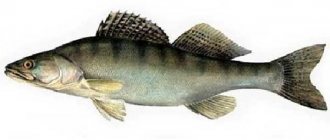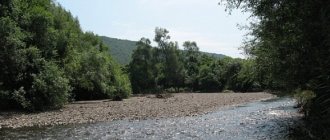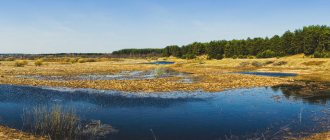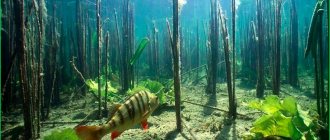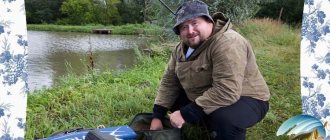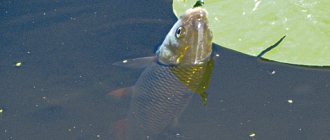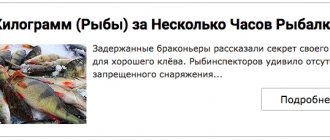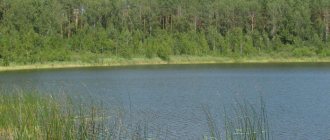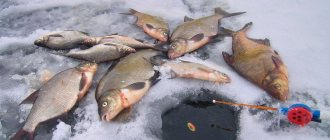Those who have long dreamed of getting away from the bustle of the metropolis for a while should go fishing. Moreover, very close to the capital in the picturesque area of the Moscow region there are excellent fishing spots. One of the largest tributaries of the Moscow River, the Pakhra, is considered a rather attractive place for avid fishing enthusiasts. Fruitful fishing on Pakhra can bring a lot of positive emotions and an excellent result in the form of a decent catch to the fisherman. Here, along the banks of Pakhra, there are many cozy villages; the surrounding landscapes are truly pleasing to the eye.
Location
The winding Pakhra River is one of the right tributaries of Moscow, its total length is 135 km. The area of its water basin is 2580 km². Having familiarized yourself with all its movement, you can clearly see that the Pakhra River on the map belongs to the Oka basin.
In winter, it is covered with a strong layer of ice, and in the warm spring it is again opened from the ice cover. On the banks of this reservoir there are many beautiful towns and villages where you can see buildings of ancient architecture. The ancient settlement of Ostrov is another confirmation of this. The current of this river is quite quiet and calm, ideal for summer swimming.
Text of the book “8000 fishing tips from an expert”
Spring fishing on Pakhra
Pakhra is attractive due to its proximity to the capital. Spring is the most favorable period for fishing on this river, when fishermen's trophies often include large roach, humpback perch, pike, bream and bream, chub, and silver carp.
First, about the river itself. The source of Pakhra is in the Naro-Fominsk region, and the mouth is near the village of Myachkovo. The Pakhra flows not far from the south of Moscow and flows into the Moscow River. Its length is 129 km. Pakhra receives about 230 tributaries; Among them, fishing is quite interesting, especially in spring, on the Desna, Moche, and Rozhae rivers. In the upper reaches, the river valley is shallow and the bottom is rocky. After the confluence of the Sokhna River, the Pakhra valley becomes deep, and below Podolsk it becomes wide (up to 3 km). In the middle reaches of the river, the depth is generally up to 3 m, in the lower reaches there are holes up to 7–8 m. The river is meandering. Its width, starting from Podolsk, is on average 40–50 m. Below this city, the Pakhra flows through clay and limestone rocks. The latter are washed out well by the current, which is why there are many holes in the river. In addition, many tributaries of the Pakhra flow into it underground, hiding in karst labyrinths. Landslides often occur on steep river banks.
Wiring.
Fishing with float gear on Pakhra is carried out with varying success throughout the year, even in winter - in non-freezing areas near the dam. However, the success of spring fishing is determined by certain factors, among which we highlight the main ones:
– onset of pre-spawning and post-spawning fish feeding;
– establishment of favorable living conditions (normalization of flow, illumination, oxygen saturation of water and its temperature, etc.);
– revitalization of invertebrates living in the water, which now manifest themselves more often and become available to fish.
The main attraction of Pakhra in the spring is its readability. Since the river is rich in riffles, holes, dams, channel narrowings and expansions, it is easy to calculate the “points” of fish exit. Despite the fact that the chub, bream, silver carp, and roach that live in Pakhra are not afraid of strong currents, when going out to feed, they will avoid standing on it for a long time - why waste energy in vain. These fish often watch for food floating with the current, hiding behind some kind of shelter. There are plenty of them on Pakhra. Here, the strong current often gets in the way of trees, snags, boulders, and rocky ridges that have fallen into the water. In addition, you need to take into account that food dragging along the bottom - larvae, weakened crustaceans and other invertebrates - settle and are carried to calm water where there are breaker jets. This often happens behind capes, spits, and sharp turns. In addition, the fish finds food at the beginning and end of shallow holes following the shallow riffle. All this and other nuances must be taken into account when fishing with a wire rod.
Usually they fish with bait at depths of 2–4 m, placing the bait in areas where water-dwelling organisms are most often found: along algae, over rocky ridges, near snags, near old piles, etc. In addition, when fishing in mid-water and on top It must be taken into account that insects and their larvae that come to life in the spring sun most often end up in the water where there are thickets of trees and bushes along the banks. The equipment is often used “blind”. The float test and model are highly dependent on the fishing depth and the strength of the current. In the spring, the fish take quite actively, so floats designed for a load of 1.5–2.5 g are quite suitable. Usually, when going to Pakhra, I take two wire fishing rods with me. I use one for catching large fish - bream, chub, solid roach, the other for catching minnows, bleak, roach, perch. I equip the first fishing rod with a main line with a diameter of 0.18 mm and a leash of 0.16 mm, the second with 0.14 mm and 0.12 mm, respectively. To catch small fish, thinner lines could be used, but on Pakhra there are many snags. The float on both fishing rods is replaceable. It is fastened with a tiny carabiner to a loop of soft wire folded in half - it stops the cambric. The latter moves slowly along the line.
Many Pakhra fishermen fish exclusively near dams. One of these places is the dam in the Gorki Leninskiye area. The water falls here from a height of 6 m and first runs along a shallow bed made of concrete slabs. Next comes a bedrock bed with depths of 1–2 m. They fish both from the shore and by wading. In early and mid-spring, roaches here take well to various baits of animal origin: bloodworms, maggots, dung worms or dendrobena. As the water warms up and mulberry algae grows, this roach bait works best.
In some areas of Pakhra, the tackle, popularly called “bye-current,” performed well. This is actually a wire rod with a very light rig. One or two pellets with a total weight of 1–1.5 g are used as a load. The main line is 0.15–0.17 mm. The leash is 15–20 cm and has a diameter of 0.2–0.3 mm smaller than the main line. The float is of the “goose feather” type. The fishing depth is 3–4 m. For wiring, the fisherman selects an area with a hole (one or several) at the bottom. Wiring is carried out by dragging along the bottom. Bites happen more often when the bait comes out of the hole. The float seems to be submerged all the time. It is necessary that one of its tips be visible.
On a fishing rod with a side nod and a jig.
I am a big fan of this gear and have achieved the best results in the spring. On Pakhra, I had to catch large perches, small and medium-sized chubs, bleak, bream, bream, roach, ruffe, and gudgeon with a summer jig. When choosing locations, they focus on quiet-water areas near coastal algae and shrubs. In calm water, it is much easier to imitate the spasmodic movements of an amphipod crustacean that has grabbed prey in the form of some larva, suitable for the given time, attached to a hook. Before algae reaches the surface of the water, you need to focus on shallow bays and other areas that are bypassed by fast currents. Immediately after the flood waters recede, good fishing with a jig can be found near the walls of last year’s reeds, snags protruding from the water and near the crowns of trees and bushes hanging over the water. In bays and near snags, you need to start playing with a jig from the bottom, at the first stage moving it several times on the ground to raise the turbidity. Under the branches of trees and bushes hanging over the water, they often play from the surface to the bottom. In this case, after 20–30 cm of descent, it is recommended to make short stops for the bait. Sometimes it is at such moments that a bite follows. In the latter case, fishing from the surface is due to the fact that in the spring the larvae that live in the bark of trees wake up. Sometimes they end up in the water together with adult insects. The fish, knowing this, watches for prey under coastal shelters, which also serve as good protection from the predator active at this time. For the surface fishing method, baits such as burdock moth larva, maggot, bark beetle larva, and underleaf worm are best suited.
Even in Pakhra, they often practice an unusual method of fishing with a jig - dragging. Places for fishing are chosen near dams - where there is a fast current and piles of boulders. Roach, perch, chub and other fish in such areas often huddle close to the shore, where the currents are weaker and where in the ground potholes you can calmly watch for what the water released by the sluice carries.
The fishing tactic is to drag the bait along the washed-out shore (close to it). The fisherman himself squats so as to be invisible to the fish, since roach, perch, and chub here often stand at a depth not exceeding 0.3–1 m. It is known that it is near the dams that underwater rocks are favored by colonies of various invertebrates on which the fish feed. The jig used is not very light, but not too heavy either. The first stream carries it away very quickly, and the second will easily fall between the stones, which threatens with blind hooks and inevitable loss of bait. It is better to take medium-weight flat-oval jigs that glide in the current, hitting rocks, rather than imitating crustaceans and larvae that could not stay in the flow.
To prevent the nod from bending too much under the pressure of a strong current, it is made more elastic. Therefore, the nod plate should be shorter and wider. For fishing with a jig on a stream, it is quite possible to use retractable nods made from a lavsan plate - they are intended for winter fishing on a balance beam.
Near the Pakhra dams, baits such as amphipods, red worms, mayfly larvae, and dragonfly larvae have performed well (the latter is easy to pick up in the roots and stems of algae in the spring, which Pakhra is rich in).
To the donk.
This gear on Pakhra gives excellent results, especially where fairly crowded shores force large fish to stay away from the shore. This fishing is practiced on this reservoir immediately after the ice melts, while the water is still low and not disturbed by the flood. From the 20th of April, in the area from the village of Yam to the dacha site “Solnechnaya Polyana”, bream and roach are caught well on the bottom, and towards the very end of the month, large silver crucian carp begins to show itself very actively.
To catch these fish, I most often use a sinker feeder in my rig. For me it is usually a lead rod bent in the shape of a horseshoe, and both sides of this horseshoe are intertwined with millimeter wire through holes drilled in the lead. The hook leads are attached to the main line just above the feeder sinker and then passed through cambrics tied to both sides of the horseshoe, or through special channels made inside the lead. At a distance of 5–10 cm, hooks No. 6–8 are attached to the leashes. In such a heavy mesh, viscous bait holds well, which, washed out by the current, lures the fish to the bait. However, today there are a lot of options for different feeders, and various models go on sale. All of them are good in their own way when catching carp fish. A donka with a feeder should be a mobile tackle, so I use a reinforced picker rod to cast it.
When preparing bait, you need to take into account that its certain viscosity is important for uniform washing out of the feeder by the current. Composition of bait for fishing in the middle reaches: 450 g of steamed millet, 200 g of wheat bran, 200 g of breadcrumbs, 200 g of maggot, 200 g of crushed oatmeal, 100 g of cake. The bait must be mixed thoroughly.
From the end of March to the beginning of May I use maggots (up to 4-6 pieces on a hook) and a bunch of red worms as bait; later the range of baits expands through the use of steamed pearl barley and steamed wheat (I put 2-3 grains on a hook).
The casting point for the equipment is further than the middle of the river or under the opposite steep bank. An improvement in the bite is always observed from the moment the dam opens, when the current increases. At this time, the fish moves in search of food. In the summer I fish with 2-3 donkeys using different baits, but in the spring it is enough to use just one donkey. In this case, the fisherman is not tied to one place. He moves mobile along the shore, checking the most promising “points”.
Where to go for what kind of fish.
Regarding fishing for certain types of fish on Pakhra, the following can be said.
Chub.
Good areas for catching chub (sometimes you can catch quite large ones - up to 1.5 kg) are located along the river from the dam near the village of Novlenskoye to the dam in the village of Volodarsky. Particularly worth noting is the right bank of the river in the area of Kalinin’s dacha and the areas below the two dams. Main baits: bark beetle larva, maggot, red worm (Dendrobena and similar), dragonfly larva.
Bream.
Good bream fishing with donks and retrievals can be found in the area of the Solnechnaya Polyana gardening partnership, however, it is sometimes complicated by the fact that poachers set up their nets here. Two to three weeks before spawning and some time after it, the bream is eaten off. It comes out of a hole to feed, located 500 m below the community, onto rocky ridges with a depth of 2–4 m.
Other good “points” for catching bream are located in the area of the village of Yam and the village of Myachkovo.
The rules for using baits are the same as for silver crucian carp: before spawning - maggot, worm, closer to summer, steamed cereal grains begin to work well.
Goldfish.
Massive feeding of silver crucian carp is often observed in late April - early May in the section of the river from the village of Novlenskoye to the village of Churilkovo. Sometimes it bites well in the area of the Solnechnaya Polyana gardening partnership, the village of Volodarsky and in the estuary area of Pakhra. They catch it here using a half-bottom, a bottom or a retrieve, calculating so that the bait is close to the algae that are beginning to make their way to the surface.
Roach.
In Pakhra this fish can be caught everywhere in the spring. However, the most productive areas remain in the area of the two above-mentioned dams, as well as above and below the bridge near the village of Zelenaya Sloboda. Good results are obtained by fishing with jigs near coastal shelters and by retrieving in medium and fast currents.
Perch.
It is very actively caught throughout May from young water lilies, walls of young sedge and other aquatic vegetation using small and medium jigs, which are equipped with a nodding fishing rod. The best bait is a dragonfly larva; the perch takes it decisively. You can also use a red worm.
Routes.
Pakhra is quickly and easily accessible both by personal and public transport. Bus service to settlements located along the banks of the river is constant.
Here are some routes.
1. Travel from the Domodedovskaya metro station by regular bus to the village of Volodarsky or Churilkovo, then walk to the river.
2. By train from Paveletsky station to the village of Leninskoye, then walk downstream 1–3 km.
3. By bus going to Domodedovo, from the station. metro station "Domodedovskaya" to the village of Yam, then further downstream or upstream on foot.
Travel by personal vehicle: along Varshavskoe or Kashirskoe highways, then along secondary asphalt roads running along the banks of the river (15–30 minutes drive from the Moscow Ring Road).
On Lake Shlino
On the border of the Tver and Novgorod regions, not so far from northern Seliger, there is a stunningly beautiful Lake Shlino, shaped like a slightly broken triangle. Bays overgrown with reeds, several picturesque islands, an almost entirely sandy bottom and shores covered with coniferous forests with rare villages, whose houses and bathhouses approach the water itself - all this does not leave indifferent a fisherman, a tourist or just a vacationer who has ever been here.
There were three of us. We stayed at the Hunter and Fisherman's House of the Berezaisky hunting estate, which belongs to the Military Hunting Society. It is located on the edge of a forest near the village of Krasilovo and has a barracks-type hotel designed for 50 people. At the Hunter and Fisherman's House we rented a motorboat and a rowing boat. From a conversation with the director of the hunting farm, I found out that the lake is famous for its large deep-sea pike. As it turned out later, it has a somewhat unusual, bronzed color, and the capture of individuals measuring 3–5 kg in size is a common occurrence in these places. I also learned that, in addition to pike, in the reservoir you can successfully catch humpback perch, bream, heavy roach, rudd and tench. During the cold season, especially in winter, burbot takes off the ice, sometimes of quite impressive size. The average depth of the lake is 4–6 m, near the shore there are quite extensive areas of sandy shallow water, often with islands of uruti and snags; closer to the middle of the reservoir there are holes up to 10 m.
Most visiting anglers here catch pike by trolling. Some of them are quite “coolly packaged”: they bring with them beautiful boats on trailers, expensive motors. The venerable pike on this lake must have an echo sounder with him, since on the endless expanses of the sandy bottom the pike is most often found on the edges or on other prominent terrain. In addition, the echo sounder will show the presence of driftwood at the bottom. One of our friends told me that he more than once saved expensive baits by avoiding logs lying on the bottom that were detected by an echo sounder. Once, when the boat was moving a little faster than usual, and the echo sounder suddenly showed a snag at the bottom, his wife did not have time to reel in the fishing line in time, and they lost the most catchy wobbler. By the way, as I understand it, trolling is an activity ideal for family recreation. It’s not for nothing that we saw so many fishing families on Shlino.
As for trolling baits, large deep-sea wobblers work best on this lake: large 20-25 cm vibrating tails on a 40-60 g jig head and white “shakers” measuring from 10 to 18 cm. The long-used one showed good results fishermen "Storling".
Not having sufficient experience in trolling, Gennady Panteleevich and I did not dare to engage in this fishing on the first day. We stopped the Kazanka over a rocky ridge near the nearest island, which local fishermen told us about, and began fishing with a spinning rod. The bottom in this place was without sharp drops, and the depth was 1.5–2 m. On the second cast, I caught a 400 g perch with a “Muran - Tony-z”, with a white petal. The perch here is dark in color, as if smoked. Another cast to the same place - and again the same handsome man came briskly on the line. Unfortunately, we forgot to put an anchor in the boat, and the wind quickly carried us away from the fishing spot. I was later unable to find the concentration point of large perch, no matter how hard we tried. After that, we swam to the reeds near the island and took cover from the wind behind the forest growing on the island. The boat stopped being demolished.
Since there were many islands near the reeds, difficult to see in the ripples of algae, we had to switch to fishing with “spinners” with a light core, however, except for a few medium-sized perches, we were unable to catch anything. The casts turned out to be close, no further than 30 m, especially if you throw towards the wind. The boat was noticeably drifting even beyond the island, so it could scare away “large fish” in the immediate environment - throwing it at such a distance was ineffective. Risking frequent snags, I switched again to the “Muran” - this small spinner on a 0.12 mm braid flew me about 60 meters. At this time, my partner just suggested moving on the motor to the other end of the island. While he was turning it on, I cast to the reeds, and the moment the spoon touched the water, it was grabbed by a one and a half kilogram pike, which was soon caught in the landing net. Soon, cruising along the reeds brought us several more small pikes. I was glad that the “laces” did not come across. For myself, I once again noted that on a too bright day, when fishing in shallow water, it is better to make casts towards the sun - then it will not blind the predator pursuing the lure. Judging by the perch, which sometimes followed the lure all the way to the boat and did not take it, the predator was inactive. Sometimes it was possible to provoke a perch into a bite by an unexpected slowdown in the retrieve.
Surprisingly, when I lost the catchy “Muran” (it flew away during an unsuccessful cast along with a frayed tungsten leader), my bite stopped. I also had a similar “Muran” with a black petal in stock, but no matter how much I threw it, it did not show itself. I used to successfully catch chubs and ides with this Muran model, but there are few of them in this reservoir.
Overall, we were pleased with our first day of fishing. When we approached the village pier, where the Kazanka was locked, we met our third comrade, Valery Stepanych, who was just raking out the coastal reeds. He happily told us that the bite of the white bream was excellent, although there weren’t many large ones caught, and showed us a cage filled with fish that he had lifted from the bottom of the boat.
The next day, analyzing the experience of catching Stepanych, I decided not to go far, but to catch it by wading near the village. As soon as it was dawn and the foggy outlines of islands began to appear in the distance on the lake, I put on my wading pants and went into the reeds to the left of the pier. There are free windows of clean water - so I began to lower the jig of the nodding fishing rod into them. For bait I used dung worms, which Stepanych dug up at his dacha. I tried fishing with maggots, but the fish didn’t show themselves. Within a few seconds there was a bite, and, folding the telescopic rod, I brought a rather large roach to the landing net on a short line. Then the little breams began to greedily peck every now and then. I decided to look in the reeds for another window. When I moved to a new place, I immediately caught two three-hundred-gram white bream, but then the small stuff came again.
I decided to feed the place. In my backpack I had a bait mixture that consisted of Bob Nudd's HI-PRO Specimtn dry groundbait (50%), Hercules dry flakes (20%), wheat bran (15%) and steamed millet (15%) . A few minutes after feeding, the bite of the little things intensified. She began to bite on every cast. And suddenly there was a confident tilt of the nod, and I felt that the jig was grabbed by a standing fish. A few minutes of struggle crowned my victory over the six-hundred-gram white bream. On the next cast I bit about the same one, then another, this time small, but a bream. I realized that a flock had approached and had driven away the little things. What a fishing trip! The large bream took greedily and constantly, both when planning the jig - at the bottom and in half-water, and when it slightly fluctuated near the very bottom. I used a small jig - a black “droplet” with a hook No. 10. For a large bream, I attached small worms (2-3 pieces each) in a bunch. Sometimes there were gatherings, and the fish moved away. Immediately small things began to bite, including roach and rudd. Then I threw in a little bait, after which the bite of large fish resumed. Soon the fish tank was already weighing heavily on my waist belt, and I went to find out how Stepanych was doing - he was fishing in the reeds nearby. My friend also attacked a large bream and attracted the flock with bait. But what’s interesting is that, while trying to fish with a float rod in different areas of the reeds, in one place he caught two lines of four hundred grams each, and he also had a 0.15 mm break in the leash - something serious bit.
Finally it came to trolling. We decided to devote the third day entirely to him. We got up quite late. Our new friends told us that there was no point in going out for pike before nine o’clock. In general, it actively fishes here from 9 to 11 o’clock, then it is caught with varying success until the evening; with the onset of dusk, the bite stops. But yesterday these rules were refuted: when it began to get dark, we swam up to the fishermen who continued to shine from the boat. They said that they continued to fish because there was nothing to do, they say, there would be no more bite, but right before our eyes one fisherman got a bite, and he pulled a good pike into the boat. This happened right next to the village.
In any case, on the final day Gennady Panteleevich and I were going to fish all the way. Valery Stepanovich, as in previous days, went on a boat into the reeds with a float rod. Of the trolling baits, we only had large “shakers” and a couple of medium-sized wobblers. At the pier, Gennady Panteleevich met a fisherman he knew from Vyshny Volochok, Valery, with his wife and son. He boasted about his new echo sounder, showed us huge wobblers and vibrating tails, saying that only such ones here can tempt large pike, and fishing with pieces of iron like “Storling” is already a thing of the past. Valery recommended that, since we do not have an echo sounder, we walk along the opposite shore at a distance of 100–150 m from there to the second cape - supposedly there he caught a good pike two weeks ago. He himself, with his echo sounder, will look for new “points”. We followed Valery’s advice, taking into account the fact that on the first day of our arrival, some anglers caught good pike over an underwater bank, which was located somewhere between the second cape and the islands. According to those fishermen, there should be stakes sticking out of the water near the banks, near which breamers are often caught.
We had two spinning rods thrown - we held the rods in our hands. My bait release was 100 meters, and my partner’s was 50 meters. First we installed deep wobblers, then switched to Finnish “shakers”. The speed of the motorboat was the slowest, sometimes you could feel the bait jumping on the shell rock (occasionally we pulled out a toothless hook caught on the hook) or on a rocky ridge. But mostly there was a perfectly clean sandy bottom, so it seemed that the bait was moving in the water column, and then I began to get nervous, asked to slow down further to lower the spoon lower, or attached an additional sinker. But everything remained the same.
We had already traveled about five kilometers on the motor without seeing a single bite. Finally we found an underwater sandbank in the middle of the lake, which successful fishermen had told us about. By this time I was already fishing with a regular “Storling”. And suddenly the tip of my spinning rod began to twitch, the rod began to be pulled out of my hands. I made a sweep, immediately asking Gennady Panteleevich to turn on the idle speed of the engine. I reeled in quickly enough, confident that the Kevlar leader and 0.16 mm braid would withstand even smaller fish. Nevertheless, the pike managed to make a candle, and we saw that the specimen was quite good. Soon, my partner hooked a about three-kilogram pike with a capacious landing net. By the way, about the landing net. Gennady Panteleevich said that when he was here last year, during a two-hour sail from the village of Krasilovo towards the village of Kamenka they had fifteen pike bites, but as a result there were only six trophies in the boat. And all because the landing net was small and shallow for such a large pike - when it hit it, it left.
Soon I felt that the depth had increased again, and I told Gennady Panteleevich that I needed to go over the bank again. He began to turn in a wide arc, but suddenly his vaunted American engine stalled. He didn’t let us down for two days – he worked perfectly. And then it won't start. We began to investigate and discovered a leak above the fuel pump. Looks like a gasket has blown. We, as not specialists, but simply users, did not know what to do with it. Having turned off the gas tap, we decided to row to the base. With the heavy “Kazanka” the work was not easy – four kilometers in a straight line, no less. After two hours of alternating rowing, when we were already a kilometer from the village, we saw a motorboat coming towards us. As she approached, they recognized Valera, her wife and daughter. He took us in tow and said that in the morning they managed to catch three respectable pikes using the baits they showed us.
Finally we arrived at the pier. Another fishing family we knew was already unloading there. I approached Vladimir and Lyuba to inquire about their catch and saw their son Vanya laying out pikes on the bow of the boat. All – from 2 to 4 kg. Not bad! He asked what they were fishing for. It turns out that every single pike was caught with an ordinary “Storling”. So understand what to believe - new or old. In response to these thoughts of mine, a local fisherman standing on the pier remarked:
“When she takes here, she gets caught in everything.”
I thought we would calm down on this. But when I was lounging at the hotel during the day, Gennady Panteleevich came and happily told me that he had taken the Veterok from the director of the base and had already fitted it to the boat. All that's left to do is go out and troll. We went towards the islands along our coast. At first there was no sign of a thunderstorm, but soon the horizon quickly darkened and lightning began to flash. We saw Valerina's motorboat near the islands and swam up. He added three more trophies to his previous ones - one pike looked to weigh six kilograms. Valera said that he took all the pikes along the edge, which stretches for several hundred meters between the nearest island and the left bank. When we swam, Valera began to correct the direction with his hands. But the storm was quickly approaching. Gennady Panteleevich said that it is dangerous to be on the water during such a thunderstorm. I waited until the last minute. It was not raining yet, but lightning was already falling very close when we, quickly putting away the gear, went “at full speed” to the base.
As soon as we landed, such an amount of water, mixed with hail, suddenly poured from the sky that our backs began to hurt. We threw our things into the kitchen where we kept our gear and climbed into it ourselves. They settled along the walls, since the roof was leaking heavily in the middle, and began to look at the flood through the open door. A sudden gust of wind pushed the massive iron door and it slammed shut. I began to feel around with my hands for the inside handle, but it wasn’t there. We were trapped. If something happens, they will be looking for us for a long time. Not a single window, nowhere to even shout.
The rain continued for about two hours, then began to subside. I looked through one of the holes (apparently someone had once shot the kunh with buckshot): I saw a woman approaching the pier. He started knocking loudly on the door. Then, as the woman approached, I asked her to turn the handle on the outside. It turns out that she and her husband on the bridge leading from the pier forgot the fish tank, and the fisherman went to get it, otherwise it would have been unknown how long we sat here, because it was already evening...
The next day we left for Moscow, sadly parting with this beautiful lake. We did not regret that we caught less than others. But we tried out different fishing methods here and experienced some action.
Finally, I wanted to take a few landscape shots, and I persuaded my group to stop by the village pier again. I saw an old man with a fishing rod, standing in wading pants in front of the baths. Every now and then he snatched small fish from the water. When I approached him with the camera, he said to me:
- Why are you sneaking up on me like a duck? You better go over there and take a photo of my grandmother.
It turns out that standing opposite the distant bathhouses in waist-deep water is none other than an elderly woman. She and this old man, her husband, go to the lake to get change for their cat and to catch some fish for themselves. This is how much enthusiasm you need to have to catch in such a sporting way at an old age! The old man shared useful information with me:
“It’s not easy for me to fish in front of the bathhouses.” After all, today’s vacationers at the bathhouses have feasts, and they throw food waste into the water. In addition, when they swim, they stir up the bottom with their feet. So the fish hangs around here - looking for food.
In conclusion, I would like to say that the no less beautiful and fishy river Shlino flows out of the lake, which, after running through a wooded area for about a hundred kilometers, flows into the Vyshnevolotsk reservoir. Anyone who loves kayaking and fishing will get an unforgettable experience from rafting on the river. In addition to the fish that are found in the lake, it is inhabited by chub, ide, grayling, ruffe, and gudgeon.
Fishing on the Pakhra River: places
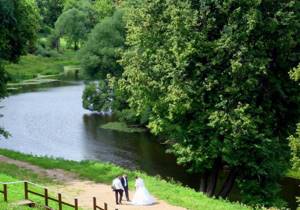
A unique feature of this beautiful river is that it winds quite a bit, due to which the relief can change every 10 meters. It is for this reason that beginners in the field of fishing are faced with the problem of carefully checking the bottom topography before starting fishing.
Even if an amateur found fishing spots during last fishing, this does not mean that this year the bite will be as good as last year. Despite these pessimistic forecasts, many experienced fishermen advise beginners to fish exclusively in the same place.
The most popular fishing spots include sections of the river near the dam near the small picturesque villages of Shaganino and Novlenskoye. These beautiful places are quite promising for experienced fishermen. Below the Novlenskoye river dam, chub and large asp can be successfully caught with regular fly fishing and a strong spinning rod. Below these dams, in reservoirs created in these places, trophy bream and carp can be found. Most often, people fish in the section of this river from the mouth of the Rozhaika flowing into it up to the dam at Yam. In the Yam area, fishing is no less fruitful.
Feeding and catching bream
Usually the starting bait
is made by hand, throwing 12-15 balls the size of an orange. Having placed the plug on the holder, try to place all the balls under the whip as accurately as possible so that they lie in a heap and, if the bottom is sloping, do not roll further than the reach of the tackle. After this, you have 15-20 minutes to do other things, for example, drink tea. We start fishing with the lightest tackle, putting one or two bloodworms on the hook. When there is fish at the point, you will notice it immediately. But which one? If you start to take out small change, it means that everything is in order, the process is developing according to the scenario you need. Gradually, one type and size of fish will be replaced by another, and the probability of waiting for the bream to come out is very high. If on the first retrieve you hook a large fish, then most likely it will be the last one. You catch small fish, and suddenly there is a pause in the bites. It was the bream that came up. Woe to anyone who at such a moment decided to loudly exchange a phrase with someone or throw a lump or two of bait. When fishing for large fish, you need to exercise maximum caution, because the escape of bream even in the upper layers frightens the school, and even if it’s below... I don’t even want to think about it. It is necessary to use various methods of retrieving, provoking the fish to bite: free swimming or step retrieving, slowly raising the equipment above the bottom and lowering it, retrieving against the current, holding the tackle in one place. You need to constantly try and look for the best option. But we should not forget that bream does not like sharp, fast jerks of the equipment. It is better to supplement with a special cup of Pole Sir, starting with one small ball. It is not known exactly how the fish will react to this today, so it is better not to risk it and start with small doses. If you feel that the fish is not afraid of your actions and has become more active, you should feed more often and more boldly. With the right actions you can collect so many fish that the bream will even turn purple at the fishing point. Of course, not always, but there are catches on Pakhra for 20 kg. Do you need that much? Take a few for yourself, take them to your mother-in-law, and let the rest of the fish swim and give birth. After all, fishing and life don’t end tomorrow
Vasily Mecherin - Fish with us
Types of fish
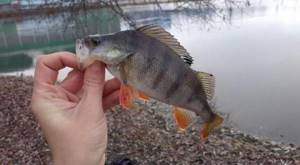
In the clear waters of the ornate Pakhra River there are such species of non-predatory fish as roach, bleak, dace, asp, chub, beautiful crucian carp, bream, silver bream, tench, carp, perch, ruffe, predatory pike, gudgeon.
There is practically no catfish, pike perch, or fish of the sturgeon family here either, but almost any angler, be it a bottom fisherman, a spinner or a floater, will be able to find something to his liking due to the unlimited possibilities of fishing here.
Bream fishing
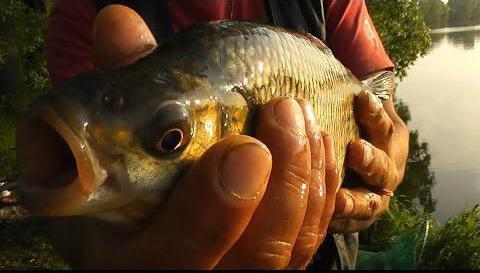
For many lovers of traditional float gear, fishing on Pakhra is associated with exclusively peaceful fish, with bream in the first place. It is found here in unlimited quantities, and its size is also impressive. At the end of summer and beginning of autumn, bream begins to gather in slender schools and begins to migrate in the direction from the dam near Yam to the mouth of the beautiful Rzhaika River. This is not only the time of active movement of bream, but also the period of its feeding. It is then that it is simply excellently caught, and plow fishing in the Yam area can bring a decent result. The school stays in this place for a period of 5 to 7 days; here it is important to detect the maximum catch point in time. The opportunity to become the owner of a hefty bream is offered by fishing on the Pakhra River, the places near which are one better than the other.
To catch bream at this time, you should pay close attention to its right bank. This is due to the fact that the river bed on the right side is closest to the shore, making it very convenient to fish directly from the shore. Bream itself is a rather sensitive fish and reacts quickly to a boat, so it will be more convenient to catch it while standing on the picturesque bank of the beautiful Pakhra River.
The main thing you should pay attention to when catching this species is the choice of appropriate gear, taking into account the depth, distance and behavior of the fish. For fishing from the shore, it is best to use Bolognese or traditional match gear. It all depends on the weather conditions, for example, in bad weather and side winds, bream fits perfectly on match gear. And in clear, windless weather, Bolognese tackle with an average rod length of 6-7 meters is relevant.
One of the best places on Pakhra for catching heavy bream is the picturesque area near the village of Yam. The current here is quite weak, so it is important to remain quiet while fishing, because even a little noise can scare away the fish for a long time.
During the hot summer period, the average fishing depth is 2-3 meters, later the fish begin to go to greater depths. Before you start fishing on Pakhra in the Yam area, you need to carefully check the bottom for irregularities using a special device, because they increase the chances of catching an impressive trophy bream.
Pakhra bream
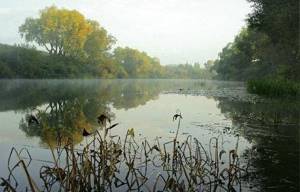
It is inhabited by bream, roach, perch, carp that entered the river from cultural fish farms, gudgeon, bleak, chub, pike, asp, and crucian carp. Populations of each of these fish are large but concentrated in certain areas. For example, crucian carp and gudgeon are most abundant above and below the dam, near the village of Yam. Chub are often found not only below the dam, but also 1.5-2 km above. Asp, like carp, is found almost everywhere, near numerous pits. The pike has taken a liking to some of the few areas convenient for it. The river is interesting not only for the abundance of fish, but also for its behavior. Gudgeon, crucian carp, pike, chub and asp are caught in very specific places from year to year, but roach, carp and especially bream often migrate several kilometers in both summer and winter. It is difficult to answer what this is connected with, but it can be assumed that the main reasons for migration are the search for food and changes in water quality. Unfortunately, Pakhra was and is being polluted by industrial wastewater, only the Podolsk Battery Plant was replaced by underground workshops on the banks of the Pakhra tributary, the Rozhaika River.
Season and places of fishing
For float anglers, the main object of hunting is large bream. At the end of August - beginning of September, it forms large, dense flocks and walks along the river in the area from the mouth of Rozhaika to the dam at Yam.
Bream not only constantly moves, but also feeds very actively and bites well on the bait offered to it. A flock rarely stays in one place for more than five to seven days, so it is important to get to the “cool” place in time.
Judging by my experience, the river flood area above the dam is now very promising for fishing. The right bank is preferable, since here the riverbed comes relatively close to the shore and there is no need to use a boat. Despite the considerable depth, bream senses the boat and is careful not to approach it, so it is worth fishing from the shore, choosing the appropriate gear. Anglers, as a rule, avoid this area, since in summer it is much more convenient to fish either at the bend above the bridge, or, conversely, below the dam behind the bend in the riverbed.
The channel passes closer to the right bank even before the flood begins and stretches almost to its middle. Then it turns towards the middle of the spill, towards the dam outlet, and can only be reached with feeder gear.
In my opinion, the most promising spots for bream fishing are located below the power line and almost to the very right corner of the dam. The first place is characterized by the fact that the channel runs along the shore and the lower edge with a depth of slightly less than 6 m is located at a distance of 25-30 m from the shore.
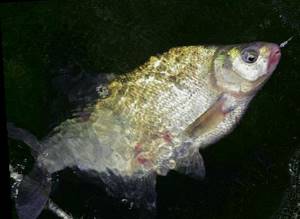
The second place is interesting because it is relatively shallow, but bream often feed here. The main thing is not to alert or scare away the fish. I prefer the first place, because here, without interfering with each other, five people can fish, but the main thing is that the probability of a school concentration here is much greater.
Gear selection
When choosing gear, you need to take into account not only the distance and depth of fishing, but also the behavior of the fish. Plug and fly rods are no longer needed, since no bait can move the bream from the riverbed to the shore at this time.
Feeder gear also becomes uncompetitive, since schooling bream constantly moves both across the area and along the water horizons.
Very often he bites when the bait falls, and sometimes the float does not have time to take a working vertical position after casting. I would consider an autumn feature to be that bream relatively rarely takes bait lying on the bottom. It reacts faster when the bait just touches the bottom or is a few centimeters higher. Of course, this behavior of fish only happens in a feeding area.
Despite the considerable depth, bream senses the boat and is careful not to approach it, so it is worth fishing from the shore, choosing the appropriate gear.
Match and Bolognese tackle remains. The final choice is largely determined by the preferences of the angler himself, as well as the strength and direction of the wind. In case of noticeable side winds and rainy weather, it is more convenient to fish with a match rod 4-4.5 m long. If the weather is favorable, and in the first ten days of September this usually happens, it is better to fish with a Bolognese rod 6-7 m long. There is another factor that must be taken into account when choosing gear.
It often happens that when the fish are highly active and the bite is short, limited to two to three hours, the speed of fishing begins to play a role. Match tackle is somewhat faster.
The equipment is mounted taking into account the fact that the bite is active, the bites are correct, the fish is quite large (from 300 g to 1.5 kg), and in addition, three or four times during fishing there are passing bites of 3-4 kilogram carp.
The main line is 0.16 mm in diameter. I make the leash (if I use it at all) from the same fishing line as the main one. If a break occurs, it occurs at the leash attachment point. You can take a thicker fishing line, for example 0.18 mm, but I am a fan of thin and high-quality fishing lines.
The design of the equipment is extremely simplified and designed for maximum fishing speed in the bottom layer. Hook Owner No. 9 or No. 11 series 53135. The small size of the hook is due to the fact that the main bait is bloodworms.
With very active biting, when a large bait is used, for example, a “sandwich” of several maggots and a bunch of bloodworms, I use small and thin tees Owner 5611-921 No. 18. The number of empty hooks is sharply reduced, but forced fishing is required, because, no matter how strangely, there are more failures from tees.
When forced fishing, the rod is directed towards the float, oriented along the line of the fishing line, and the fish is pulled out only with a reel. At the very shore, when the float appears, the rod is lifted up and the fish is taken into the landing net. This method is rarely used, but with very active biting it saves a lot of time.
Considering the decent depth of fishing, the absence of current and the relatively short distance, it makes sense to take a float with a built-in weight of about 3 g with a total carrying capacity of 8-10 g. That is, the load of the equipment accounts for about 5-7 g. Usually this is one “olive” sinker. The mass of the bait, taking into account the activity of the fish and the size of the bait, is about 0.5 g. The distance between the hook and the main sinker should be 1.5 m, since the bream often begins to take the bait above the bottom.
Then, by moving the underhang, you can choose the optimal distance between it and the hook. A long leash allows you to use the bait “to fall”, and a shorter leash transmits a bite faster. You have to select the optimal distance experimentally, not only on each fishing trip, but also during the fishing process. It happens that the peak of the bite occurs literally in the first half hour after feeding, and it happens that the fish “eats” into the bait within an hour and a half.
The equipment for the Bolognese tackle is also simple. I choose a sliding float with a load capacity of 4-6 g, an elongated shape, with a fairly thick and buoyant antenna. This is necessary so that you can change the small and light bait to a large and heavy one. The distance between the hook and the main sinker is the same 1.5-2 m. The main weight is usually divided into two parts in a ratio of 1:2. With a 6-meter rod, I place the lower float stop approximately 4 m from the hook. The 7 m long rod allows you to use a “blind” rig with a stationary float.
As practice shows, it is better to have another equipped rod in stock, in working condition and with a working descent installed on the line, since large fish often break off.
Feeding and bait
Bait is required, and a lot of it is required. Schools of bream are so numerous, and the biting period can become so fleeting, that the more bait, the better. For the first feeding, I use about 30 balls the size of an orange; approximately the same amount is needed for re-feeding, which I do approximately an hour after the start of active biting. Considering the decent depth, it is worth making the consistency and composition of the bait approximately the same as when fishing on the channel named after. Moscow.
For bream, compositions based on corn crackers, or even better, extruded corn, are more attractive. Despite the fact that fairly heavy bait is required, the balls should not only quickly fall apart near the bottom, but also produce a cloud of turbidity. To do this, you can add steamed cake and egg powder to the finished mixture. How much to add depends on the initial composition, but approximately 5% of cake and powder should be each.
For 5 kg of dry mixture, I always add about 0.5 kg of bloodworms, but not “estuary”. Very small bloodworms are of little interest to bream, so if there are no small river bloodworms, it is better to use large ones. I add the main part of the bloodworms during the second feeding, when the fish are already somewhat wary and not so active. You can fish without bloodworms, but the result can be much worse. Although the fishing distance allows you to throw bait balls by hand, I still advise you to use a slingshot, especially during supplementary feeding.
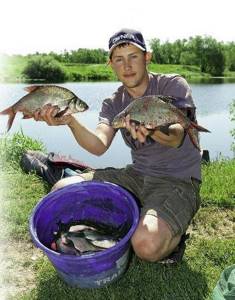
Almost the only bait I use is a bunch of bloodworms, to which I periodically add one or two medium-sized maggots. The color of the maggot does not matter. Very rarely, only when there is not enough bait, I plant maggots along with a worm. It is worth having with you not only a landing net with a long handle, but also a spacious, long net. The catch can be excessive, and it is better to release the excess fish alive and unharmed. Author - Andrey Suslin
Excellent fishing on Pakhra on the feeder
As a rule, this type of fishing begins with abundant feeding of the point using special feeders of impressive size. This fishing method has its own nuances. Hearty pearl barley porridge or cooked millet can act as effective bait. Pre-steamed coarse cornmeal is a good additive to groundbait. Each experienced fisherman has his own set of effective complementary foods and the necessary equipment for a normal catch of bream or crucian carp. Here you need to stock up on experience and have a little dexterity, because you need to throw the complementary food into the point very carefully so that the resulting stain does not blur.
With feeder on Pakhra
09/24/2014 This summer turned out to be unsuccessful for those who like to catch bream on a feeder. The fish did not bite in the best way - one might say, they only nibbled. Small bream weighing 200–250 grams were caught, but something larger was rarely caught. All hope was for autumn. Usually, at the beginning of autumn, bream pecked very actively, but in some years the intensity of the bite did not increase, but large specimens began to be caught. One way or another, bream always reacted to the first significant cold snap.
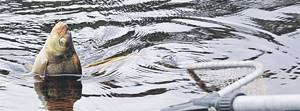
Among the rivers near Moscow, the Pakhra occupies a special place. The river is more or less fishy, with a winding riverbed, and, most importantly, it can be quickly reached by train, and even more so by car. There are always a lot of fishermen here, especially those who like to catch bream using a feeder or regular donkeys. And this is quite natural, since the river is quite deep (up to 9 meters in holes), with a gentle current. And bream up to 1.5 kg are not so rare.
Most of the fishermen are from the railway. Leninskaya stations go downstream and try to take convenient places in the pits. The largest is near the road bridge on the Don highway. The bank there is steep, and it’s immediately clear where the hole is. The place is very popular, as evidenced by the piles of garbage and, in particular, bait bags abandoned on the shore.
Unlike many anglers, I believe that in summer and early autumn, deep holes are far from the best place for catching bream. It is much more promising to fish at the entrances or exits at depths of no more than five meters. The fact is that bream goes out to feed where the current carries food, and in the pits themselves the current is very weak. This pattern is also evident on other rivers. Thus, on the Moscow River, until October, bream often catch a jig even on the riffles.
When my friend Sergei and I went on our next fishing trip, we expected to choose a suitable place at the exit of some hole and fish it thoroughly. Many fishermen try to arrive early, but we arrive at lunchtime, find what we think is the most bream place and feed the spots. Bream can go out to feed in the evening, at night, and in the morning, and in order for it to linger, there must be a plentiful spot of bait waiting for it at the fishing point.
To our surprise, there were few people on the river. Perhaps because it was quite cold. We settled down almost immediately around the bend in the river. As I knew from summer fishing, a little higher there is a hole with a depth of seven meters. As always, before starting fishing, I measured the bottom by tying a weight to the fishing line. The best point was located a little closer to the middle of the river: here the weight rested on the base of the edge. The bottom in this area is muddy, but the beginning of the rise was clearly visible. From a depth of 3.5 meters the bottom gradually rose towards the shore.
As a rule, feeder fishing begins with abundant feeding of the point using special large-volume feeders. This time we decided to change the pattern and started fishing with large, lightweight plastic feeders, recasting every five minutes. The advantage of this method is that you “shoot” towards the point. In addition, the feeding trough is heavy, and sometimes the line breaks out from under the finger when casting, and the trough goes a little to the side, which leads to blurring of the feeding spot.
Since we were going to fish for no more than a day, we took a little bait and decided, against all the rules, to do without a base. Between us we had six bags of FishBait Bream, 1.5 liters of molasses and liquid flavourings. Of course, large components had to be added to such bait. Their role is played well by pearl barley porridge or millet, but there was no time to cook them before leaving, and steaming them over a fire was too troublesome. We did it simply: we bought a couple of bags of rolled oats and soaked them in molasses for several hours. Hercules makes the bait more sticky, and this must be taken into account. A good additive to groundbait can be coarse cornmeal after soaking in water, but the store did not have the required grain. We added several cans of maggots and, of course, soil - along the banks of Pakhra there are many areas with loam, which is quite suitable. Fishing in a current without ground is simply useless; the bait will quickly be carried away by the current.
Our bait was biscuit, so we decided to add chocolate flavoring. This option may seem somewhat strange, since it is believed that sweet bait works well in the summer in the heat, but it’s already autumn. But air temperature is one thing, and water temperature is another. Despite the cold snap, the water was still quite warm.
A few words about the equipment. My main line was a 0.25 mm monofilament line and a 21 g feeder. I started fishing with a 0.1 mm leash, but quickly broke it off and set it to 0.14 mm. The partner continued to fish by 0.1 mm, but there was no difference in the number of bites. The length of the leash is 60 cm; more was not needed in these conditions. After retying the hooks, the leash was shortened to 50 cm, but the number of bites did not decrease. Hook No. 18 is the optimal size for catching one maggot with bloodworms. This combination worked well on the first day, on the second the bream caught only bloodworms, and only if there was one, maximum two larvae on the hook.
This type of gear is quite common when fishing on small rivers. But unlike the “standard” ones, we had sports half-ounce whips. Half an ounce is 14 g, but the feeder weighed 21 grams, which for many may seem more than strange, and maybe even stupid. However, it must be borne in mind that the marking of a whip reflects not so much its strength as its sensitivity. With experience and careful handling, the whips can hold a significant overload, but everything must be done carefully and smoothly. There is a certain sense in using such whips: passive fish often take so carefully that an ounce whip simply does not fix them. This happens especially often with a side wind, when there are large ripples in the water.
Although our bait was very good, the bite started much later than we expected. In the evening there were occasional bites from the silver bream, and there were bleaks - apparently they sank to the depths following the bait. Even the minnows pecked a couple of times. But there was not a single bream. We already began to think that we had made a mistake with the place, but there was no point in looking for another, since there was simply no bait left for the second thorough feeding.
The first normal bites began only at two in the morning, when we were about to go to the tent to sleep. It was as if the fish had been “turned on”, and both of them started biting at once. He took, and greedily, the same standard white bream weighing 200–250 grams. There were also empty bites, but rarely. A school was approaching, you could feel it, but there were no large fish in it. At four o'clock it was all over.
We no longer wanted to sleep, so we continued fishing in the hope that another flock would approach. The bite started again around six o'clock. This time the fish caught less often, but the bream was somewhat larger, up to 350 grams.
After 8 a.m. the bite weakened, and the bites came at intervals of ten minutes. Around noon there was another short outbreak of biting - several specimens of 300 g each were caught in a row. And that’s it, the bream didn’t take any more. Only very small silver bream pecked, which is caught almost everywhere during the day.
Between us we caught about six kilograms - not much, but this does not take into account the little things that we immediately released. Nevertheless, fishing turned out to be instructive. The bream responded to the colder weather and, apparently, began to flock together and move more. Moreover, the amount of bait had almost no effect on the approach of the flock. The fish came and went, guided by some motives of their own. Our expectation that colder temperatures would activate large bream did not come true. But hopes remain. And in past years, the peak of bream activity occurred not in the beginning of autumn, but in the Indian summer, and that is still ahead.
We are on Google+ Fisherman-Fisherman
| Author | Roman Butuzov, Moscow |
| Issue number | 38/2014 |
| Read the article | 19994 |
Rating: 3.38
Fishing with donkey
This type of tackle gives impressive results on Pakhra, especially in those areas where fairly crowded shores force the fish to move away from the shore. This type of fishing is successfully practiced here after the immediate ice melting, while the water has not yet risen to its maximum and floods have not occurred. In mid-April, in the area from the village of Yam up to the dacha site “Solnechnaya Dolina”, bream and roach fish well on the bottom, and by the end of the month the period of maximum activity of silver crucian carp begins.
Before fishing and catching bream
The fishing depth at the beginning of summer can be no more than 2-3 m, and in mid-summer and autumn the bream moves to deeper places. Then it will no longer be possible to reach it with a short rod; a plug 11.5-13 m long will be just right. Using a depth gauge attached to the hook of the equipment, carefully tap the bottom. The presence of even a small unevenness, transverse or parallel to the shore of the edge, greatly increases the chances of success. It is better if the bottom is not very hard, but not particularly silted, which is optimal for feeding bream. Before fishing, you need to make sure that the fishing spot on the shore is well prepared and cleared of tall grass. Obstacles in the water and on the shore can make it difficult to control the equipment and land fish. To clean the fishing area, there is a special device - a small sickle, sold in gardening stores. It needs to be secured to the end of the third bend of the plug and the coastal area should be cleared of plants. Be very careful when measuring depth. Take your time. It is optimal if the hook drags along the bottom and the underwater is located 1-2 cm from the ground. Drill the rig several times along the entire length of the line, both to the intended bait site and to a sufficiently large distance after it. Bites may occur here too. If there are no blind hooks, you can start preparing bait for bream
. As you know, there are no trifles in our business, but bait is the basis of the basics. Properly selected, mixed and delivered food to the fishing point is more than half the success.
Reviews from skilled fishermen
Many fishing enthusiasts consider this body of water the most convenient for spending a weekend. Of course, fishing on the banks of the Pakhra River does not always go as desired; weather conditions and other external factors interfere, preventing a decent bite. But this does not push fishermen away from the shores of this reservoir. On the contrary, they return here again and again to try their luck and become the owner of a decent catch. Here, a lot depends on the chosen fishing location, the gear used and the skills of the fisherman.
Excellent places for catching predators
Fans of predatory fish will not be left without a legal catch. Pike and other predatory representatives are found here very often and in large quantities. Spinning fishing on Pakhra is most convenient near areas with strong currents and densely overgrown banks. Fishermen have every chance to have pike perch and small perch in their catch. It is extremely rare to see an asp of impressive size here; it has practically disappeared from the small reservoirs of the Moscow region.
Fishing on Pakhra is no less popular in winter. Species of fish such as perch, roach, and bream actively bite in homemade holes skillfully created by fishermen. During the thaw period you can also find crucian carp on the hook. During the cold season, fish prefer bloodworms of all types of bait.
Composition of bait for catching bream
Now a large number of imported and domestic ready-made mixtures for catching various fish in different conditions have appeared on the Russian market. To choose from this abundance what is needed in a given place, you have to try more than one pound of bait. I have a professional approach to this matter. I spend several days a week on ponds looking for the optimal composition of bait. Since there are many fishing trips and the composition of the mixtures can be quite complex, I taught myself to write down the results of the work done after each trip, which I strongly recommend that you do too. Let's look at the rich program of bream baits from the Belgian company Marcel van den Eynde. I've been using them for several years now. This company was created more than 30 years ago, and its worldwide recognition not only among fishing enthusiasts, but also among famous float champions speaks volumes. The championships took place on completely different bodies of water, and this indicates a huge range of applications for these baits. Some Van den Eynde products have been known since the company was founded. They are so well suited for various bodies of water in different European countries that manufacturers deliberately do not change their composition and even the design of the packaging, following traditions. Record ESrazem, Gold Pro Bream, Secret World Champions Brazem have proven themselves well on Pakhra. Powdered 250-gram Brazem, black and white Exotic work well. I recommend using liquid additives in half-liter bottles: Mellasa, Big Fish, Caramel, etc. As for the basic bait, I usually use Unikorm
.
Its quantity is mixed taking into account the expected activity of the fish. Probably every car enthusiast has a small sapper-type shovel in his car. On Pakhra you will need it to dig in the coastal strip and sift the soil through a sieve. It should not be very heavy and viscous, mold when compressed, and easily crumble when a lump hits the ground. If the weather is very dry, the soil needs to be moistened with a spray bottle. It is absolutely necessary, since when mixing bait it is easy to overdo it with water by pouring it from a bucket. You can add liquid flavoring to the water in a spray bottle. Earth in an amount of at least 50% of the total weight of the bait is added only after the main mixture has already been prepared. After thoroughly mixing the soil and mixture, the bait must be passed through a sieve twice, if necessary, moisten and add 300-500 g of small bloodworms. With a small current, the lumps need to be sculpted not too dense, so that when they reach the bottom they immediately begin to fall apart. I offer bait compositions for catching bream
on Pakhra for warm (1) and colder (2) water
For captured specimens
Those who want to become owners of large fish should go to the area of the village of Volodarsky. It is here that fishing on Pakhra can bring truly trophy specimens of such fish as roach, perch, predatory pike, silver crucian carp, and chub.
Large-sized fish are best caught on a bottom far from the shore. Many fishermen successfully use a sinker feeder with this rig. Today there are many variations of feeders, all of them have their own advantages when catching carp fish. For this purpose, the donka, equipped with a feeder, must be a sufficiently mobile tackle so that it is convenient to cast this entire structure. It is possible to create such a design on the basis of an ordinary spinning rod.
Casting the donkey should be done a little further than the middle mark of the reservoir or directly under the opposite bank. A good bite is usually observed in these places at the moment the dam opens, when the current gains maximum strength. It is then that the fish move in search of complementary food. Fishing in this area is allowed using 2-3 moving bottoms with different attachments. At the time of a good bite, the total catch can contain from 3 to 10 kg of fish. Trophy specimens such as silver crucian carp and heavy carp are often found here.
Tackle for successful bream fishing
Nowadays it is quite easy to purchase good professional plug rods. True, they are quite expensive. If you can’t pay more than 1,000 euros for a stick, you can find cheaper models. Thus, the Apiko-Fish trading house, together with the Koreans, has developed some good lightweight and cheap models of plugs. For amateur fishermen and beginning “plug-in” fishermen, they are ideally suited. The fishing line must be of the highest quality. Good monofilament threads for plug-in equipment, despite the abundance on the market, are not so easy to find. I can recommend the Japanese SLR Smart. For leashes I take Tournament T-1 from Trabucco. It has a fairly high price, but the quality and all parameters correspond to it 100%. When choosing olive weights and pellets, you should pay attention to good alignment and physical characteristics of the lead. Everything in the equipment must be perfect. It is advisable to choose hooks No. 16-20 with a slightly elongated shank, made of thin wire. The range of carrying capacity of floats for Pakhra, depending on the depth, strength of the current, the presence or absence of bleak, is from 0.5 to 3 g. There is no point in putting it heavier. I suggest this rigging option: the mass of the “olive” should be up to 80% of the float’s carrying capacity. The diameter of the main line when loading the float is from 0.5 to 1.25 g-0.1 mm; from 1.25 to 3 g -0.12 mm. Additional loads located under the “olive”, under certain conditions, are lowered down to the under-grazing, increasing its mass. The shape of the float is chosen to be elongated, for still water or slow flow. It should be noted that the thinner the antenna of the float, the more clearly each touch of the fish to the hook is visible. The float needs to be slightly overloaded so that approximately half of the antenna remains on the surface. This tip is for those with good eyesight. The shores on Pakhra are different. In some places you have to sit quite high from the edge. In these cases, a landing net with a handle of up to 4 m and a long cage are required.
Great winter fishing
Fishing on Pakhra in harsh winter conditions is also common. From under the thick ice there is a chance to catch a decent bream, roach or perch. With the help of girders, pike are perfectly caught at this time. Quite a decent size perch can be found almost anywhere. During the thaw period, it is possible to catch crucian carp, which stays near wintering pits. The main thing here is to correctly identify fish exit points; in harsh winter conditions, many predators always look for areas with a minimum current level, but near a fresh stream. All this must be taken into account when creating a hole. The presence of fish-camouflaging shelters is no less important. You need to be very careful when fishing in winter, because during periods of thaw the ice is most quickly destroyed near snags and vegetation sticking out from under the ice. So making holes in these places may be unsafe.
Winter fishing is one of the opportunities that the Pakhra River offers; fishing at this time is no less fruitful.
Pakhra, Novlenskaya Dam
08/05/2014 N 55.28.907 – E 37.47.373
I have been to Pakhra more than once, and based on the results of these reconnaissance trips, I can safely say that Pakhra is one of the fishiest and most interesting rivers in the immediate Moscow region.
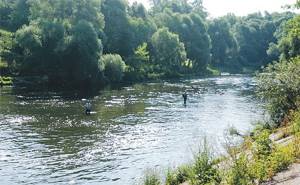
This time I decided to go to the dam built on Pakhra near the ancient village of Yam. Of course, I am aware that fishing near hydraulic structures is prohibited, but aren’t there too many prohibitions? It turns out that fishing must be closed on all ponds that are less than 500 meters long. After all, on any such pond there is a dam, that is, a hydraulic structure. Which, you see, is nonsense.
There is fog over the river, the thermometer in the car shows only ten degrees. There are already six cars parked at the dam, and there is no doubt that these are fishermen. Fish loves such places on the river, and where there are fish, there are fishermen.
Above the dam, the river overflowed, forming a fairly large body of water without a current, and below the dam, Pakhra is similar to a northern river with a fast current, shallow depth and rocks sticking out of the water. If you want, sit quietly and watch the float, but if you want, walk fifty meters and catch the line. Below the dam you can also fly fish, which is what the two fishermen were doing.
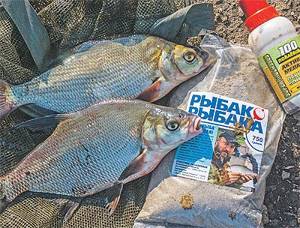
For some time I thought about where to go, and in the end I decided to stay above the dam. I found an interesting place, in my opinion, and, having prepared some bait, settled down comfortably on the shore.
The depth at the fishing spot turned out to be less than a meter, which surprised me somewhat, but did not upset me. And large fish will come here if the bait lures it.
I'm preparing two fly rods and a pickerel. Loud splashes of large predators near aquatic vegetation tempt me to pick up a spinning rod. I'm holding on. I feed. Sitting. I am waiting. Doesn't bite.
The predator does not stop fattening. A fisherman approaches. Local. He complains that everything is bad, and he came here. He tells me that he catches excellent crucian carp here in the spring using donkeys. Below the dam they catch chub and asp.
While I was talking to him, there was a bite. I hook it and realize that the fish is not small. A bream, such a good one, fat. Tempted by pearl barley in oatmeal.
And again silence. I see that the fish has approached, the float is constantly moving and there are even barely noticeable bites, but some are very careful. From time to time, at the feeding site, the predator attacks the little things that have gathered for a free feast.
It is possible to catch several roaches in a row using maggots. Apparently the predator has moved away.
A new acquaintance visited again. He doesn't have a bite. I have a bite on the pickerel. On a new high-tech nozzle. I'm not laughing. Foamed ball made from corn flour. Essentially fish popcorn that smells strongly of garlic. It does not sink in silt, floats like polystyrene foam, but in water after a while it becomes soft, which is what makes it different from the same foam plastic, plus natural corn and a variety of smells. Friends advised. But I won’t say anything based on the results of the first test.
But the purchased dough brought me another good bream. And again at that moment my new acquaintance approached. He refused the landing net he offered. I almost regretted it, but managed to grab a fish that had landed right near the shore.
Well, at least there is someone to take a photo, otherwise I don’t know how to diversify the photo series from the points I visit.
He gave all the fish he caught to him.
It's time to pick up a spinning rod. Quite quickly I realized that jigging below the dam was expensive. Ten casts – seven baits in the river. After I broke the wobbler, I decided that I really had to fish here either with fly fishing or with a bombard.
I returned above the dam and immediately caught a perch on a jig next to the aquatic vegetation. Ten minutes later another one. I admired the underwater world through my eyes: the fish were again in the shade, under the protection of a colony of water lilies not far from the shore.
There are more fishermen on the river, even though it’s a weekday. I think you should arrive early on weekends if you want to get the best seats.
DIRECTIONS
By car
Along the M4 Don highway until the turn to Vidnoye. You leave the highway and, having passed under it, you see a traffic light - here to the right. You pass the village of Yam and in the village of Novlenskaya turn left towards the dam. It can be seen from the road. There is somewhere to park the car.
By public transport
From the Domodedovskaya metro station take bus number 23 to the Novlenskaya stop.
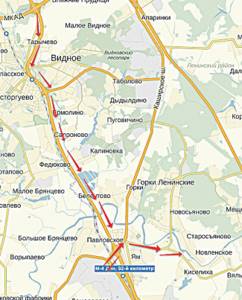
We are on Google+ Fisherman-Fisherman
a point on the map
| Author | Konstantin Alekseev, Moscow |
| Issue number | 31/2014 |
| Read the article | 38372 |
Rating: 3.29
